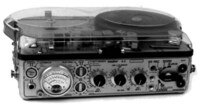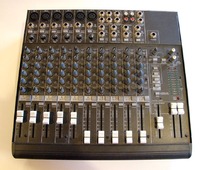![]() At first glimpse, a professional mixing board may appear intimidating to the novice filmmaker. But they are actually fairly simple to master, and are the heart of location audio recording.
At first glimpse, a professional mixing board may appear intimidating to the novice filmmaker. But they are actually fairly simple to master, and are the heart of location audio recording.
 In the olde days of 16mm film production, when videotape recorders were still too huge to bring outside of the studio, we recorded our location audio onto portable tape recorders known as Nagra's.
In the olde days of 16mm film production, when videotape recorders were still too huge to bring outside of the studio, we recorded our location audio onto portable tape recorders known as Nagra's.
Yeah, yeah, you have seen pictures of those in magazines and textbooks. But today we all shoot on digital video, so what point is the author trying to make?
The point is that when audio was recorded on a Nagra, two important factors were different. To begin with, the audio recorder was under the direct control of the Sound Mixer -- not the camera operator! The second key difference was that the audio controls on the Nagra were extremely user friendly and designed for adjusting the gain (volume) of microphones during the take.
Today, most audio is recorded directly to video (single system). That means that the audio recorder is the camera; and that the controls for the incoming audio signal are on the camera. During a take, control of the camera is the domain of the cameraperson. The Sound Mixer cannot monitor recording levels, nor sneak a finger in to tweak a miniscule knob to make subtle adjustments.
Hence, the primary value of using a sound mixing panel to control your audio, before it gets to the camera to be recorded. (And those of us who are really serious about delivering perfect audio even simultaneously backup our soundtracks to portable digital audio recorders which WE have control over. Just in case the camera pointer accidentally messes up our settings on the camera.)
 The Mixing Panel gives us smooth control over the incoming audio signals. It allows us to adjust gain (volume) of the mics, to combine or route mic signals over one or multiple recording tracks, to filter out excess low frequency noise, and to blend multiple mics spread across a set so that it all sounds as if coming from one source.
The Mixing Panel gives us smooth control over the incoming audio signals. It allows us to adjust gain (volume) of the mics, to combine or route mic signals over one or multiple recording tracks, to filter out excess low frequency noise, and to blend multiple mics spread across a set so that it all sounds as if coming from one source.
There are two types of mixing devices used in our industry: Mixing Panels and Over-the-Shoulder Portable (ENG) Mixers.
The ENG Mixers are more common. They are basically small, battery operated devices that can typically accept three or four mic inputs. Volume is controlled by rotating knobs (technically known as pots or potentiometers). There are switches for cutting out extra bass. Essentially, these are very sophisticated "Y" cables that allow you to control the volume of multiple mics and combine them into a couple of tracks.
ENG Mixers are very portable, so they can be worn by a solo cameraperson or a solo audio person who might be doubling as the boom holder (my elitism prevents me from using the term boom operator when that person is belabored with so many audio tasks as is the case when he/she is working solo).
ENG Mixers have their role in life: Electronic News Gathering, Documentary, Cinema Verite, Run ‘N Gun. When you have to be mobile and able to move around quickly, wearing your equipment, the ENG Mixer certainly beats trying to plug your mics directly into the camera.
But if the shooting environment is a bit more sedate… The camera is at rest on a tripod. There are some lights powered by AC. Maybe even a field monitor for the Director to watch. In other words, we are SET BASED.
The Sound Dept (one person trying to do it all is an overworked schlep; a proper two person crew consisting of a Mixer and a Boom Operator is a Sound Dept) prefers to work from a proper Mixing Panel.
We've all seen mixing panels or mixing boards in post-production or at events such as concerts and plays. Enough knobs, switches, and settings to fill a cockpit. Isn't that sort of overkill for basic video production?
Certainly the very large, console mixing boards are overkill. But the vast majority of mixing panels are between the size of a three-ring binder and a lunch tray. Not very expensive either: you can get very good mixers for under $500. Some are even under $200. They are actually less expensive than the good ENG mixers, which have less features, but cost more because there are less filmmakers out there than musicians.
However, musicians use their mixing panels differently than filmmakers and videographers. In this article, we are going to explain how to use a mixing board for location dialogue, not for miking a rock band.
